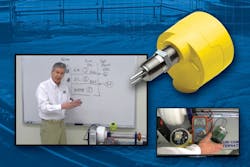Video Explains Thermal Flow Switch Operation
The FLT93S Switch performs monitoring, controlling and alarming of flow rates or levels of critical fluids such as foams, emulsion layers, liquids and slurries. Its rugged industrial design and housing provide superior reliability and long service life under the harshest plant environments in chemical refining, waste treatment and other industries.
The FLT93S Switch is a dual-function insertion-style instrument that offers either flow/temperature sensing or level/temperature sensing in a single device. A single FLT measures and monitors flow or level and temperature simultaneously with excellent accuracy and reliability. Dual 6A relay outputs are standard and are assignable to flow, level or temperature.
Unlike density displacers, which are often used for level and interface control, the FLT93S Switch relies on the specific heat transfer properties of the media to identify the interface of different products. With its unique thermal dispersion sensing capability, the FLT93S monitors the interface of products with similar densities for highly reliable control in separation tanks and other vessels.
FCI's FLT93S can identify the interface between any type of media including foam, emulsion layers, liquids and slurries. The FLT93S Switch's dual switch point option allows one instrument to control two different product interfaces. Two or more switches are used to control product discharge and intake at specified points.
The FLT Switch operates over a wide setpoint range in water from 0.01 to 0.5 FPS (0.003 to 0.9 MPS). Level/interface accuracy is ±0.25 inch (±6.4 mm), and measurement repeatability is ±0.125 inch (± 3.2 mm). The standard FLT93S withstands operating temperatures from -40 to 350°F (-40 to 177°C), and an optional configuration is available for temperatures from -100 to 850°F (-73 to 454°C).
With its advanced thermal dispersion mass flow sensor, the FLT features built-in temperature compensation which ensures repeatable and reliable operation, even in extreme environments, such as those found in the high temperature chemical refining and other process industries. This automatic compensation adjusts the instrument for changes in operating environment temperatures to ensure the trip points will remain accurate and will prevent false alarms or alarm failures to improve end-product quality, to maximize safety and to allow alarms to be set within a narrower set point range.
A wide selection of standard and custom process connections can be provided with the FLT93S Switch. The electronic control circuit can be integrally-mounted with the sensing element, or it can be located in a remote location. The standard enclosure is made from a coated aluminum alloy. It is suitable for use in ATEX locations and is rated for NEMA Type 4X (IP66) environments. Stainless steel or fiberglass enclosures also are available.
Fluid Components International - www.fluidcomponents.com
The FLT93S Switch is a dual-function insertion-style instrument that offers either flow/temperature sensing or level/temperature sensing in a single device. A single FLT measures and monitors flow or level and temperature simultaneously with excellent accuracy and reliability. Dual 6A relay outputs are standard and are assignable to flow, level or temperature.
Unlike density displacers, which are often used for level and interface control, the FLT93S Switch relies on the specific heat transfer properties of the media to identify the interface of different products. With its unique thermal dispersion sensing capability, the FLT93S monitors the interface of products with similar densities for highly reliable control in separation tanks and other vessels.
FCI's FLT93S can identify the interface between any type of media including foam, emulsion layers, liquids and slurries. The FLT93S Switch's dual switch point option allows one instrument to control two different product interfaces. Two or more switches are used to control product discharge and intake at specified points.
The FLT Switch operates over a wide setpoint range in water from 0.01 to 0.5 FPS (0.003 to 0.9 MPS). Level/interface accuracy is ±0.25 inch (±6.4 mm), and measurement repeatability is ±0.125 inch (± 3.2 mm). The standard FLT93S withstands operating temperatures from -40 to 350°F (-40 to 177°C), and an optional configuration is available for temperatures from -100 to 850°F (-73 to 454°C).
With its advanced thermal dispersion mass flow sensor, the FLT features built-in temperature compensation which ensures repeatable and reliable operation, even in extreme environments, such as those found in the high temperature chemical refining and other process industries. This automatic compensation adjusts the instrument for changes in operating environment temperatures to ensure the trip points will remain accurate and will prevent false alarms or alarm failures to improve end-product quality, to maximize safety and to allow alarms to be set within a narrower set point range.
A wide selection of standard and custom process connections can be provided with the FLT93S Switch. The electronic control circuit can be integrally-mounted with the sensing element, or it can be located in a remote location. The standard enclosure is made from a coated aluminum alloy. It is suitable for use in ATEX locations and is rated for NEMA Type 4X (IP66) environments. Stainless steel or fiberglass enclosures also are available.
Fluid Components International - www.fluidcomponents.com

